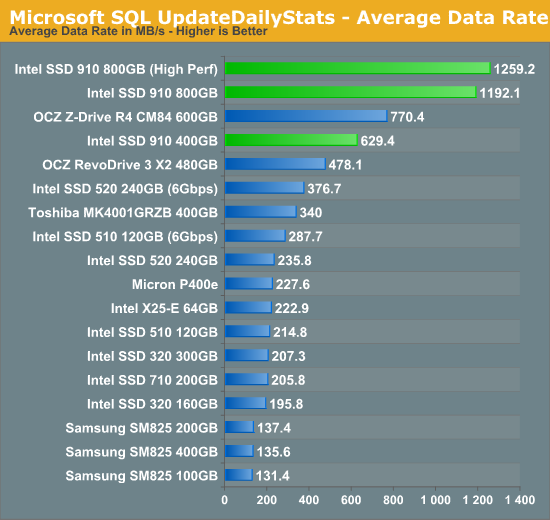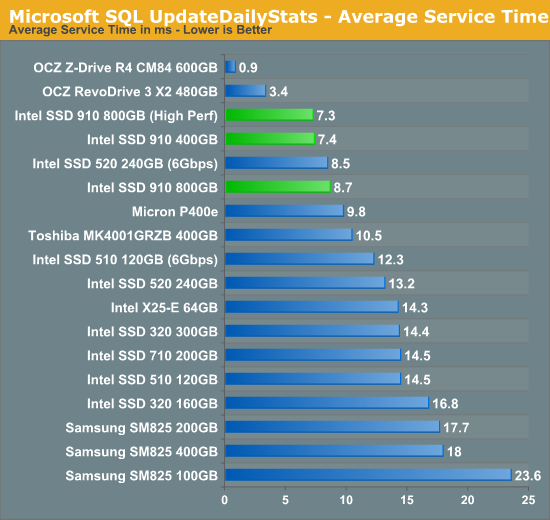The Intel SSD 910 Review
by Anand Lal Shimpi on August 9, 2012 1:00 PM EST- Posted in
- Storage
- SSDs
- Intel
- Intel SSD 910
Enterprise Storage Bench - Microsoft SQL UpdateDailyStats
Our next two tests are taken from our own internal infrastructure. We do a lot of statistics tracking at AnandTech - we record traffic data to all articles as well as aggregate traffic for the entire site (including forums) on a daily basis. We also keep track of a running total of traffic for the month. Our first benchmark is a trace of the MS SQL process that does all of the daily and monthly stats processing for the site. We run this process once a day as it puts a fairly high load on our DB server. Then again, we don't have a beefy SSD array in there yet :)
The UpdateDailyStats procedure is mostly reads (3:1 ratio of GB reads to writes) with 431K read operations and 179K write ops. Average queue depth is 4.2 and only 34% of all IOs are issued at a queue depth of 1. The transfer size breakdown is as follows:
| AnandTech Enterprise Storage Bench MS SQL UpdateDaily Stats IO Breakdown | ||||
| IO Size | % of Total | |||
| 8KB | 21% | |||
| 64KB | 35% | |||
| 128KB | 35% | |||

Our SQL benchmarks are far more compatible with the 910 in terms of IO size, as a result Intel posts the absolute best scores we've seen yet here. The 400GB drive cuts performance in half compared to the 800GB model, but you're still looking at 3x the performance from a 200GB Intel SSD 710. Toshiba's 400GB drive does very well, but Intel's SSD 520 ends up being the fastest 2.5" drive here.












39 Comments
View All Comments
web2dot0 - Friday, August 10, 2012 - link
That's why you need a comparison buddy. Otherwise, why don't we just read off the spec sheet and declare a winner? Let's face it z-drive r4 is NO FusionIO ok.FusionIO is a proven entity backed my a number of reputable companies (Dell, HP, etc...). Those companies didn't sign on because the cards are crap. Who's backing Z-Drive?
They are the standards in which enterprise SSDs are measured. At least, that's the general consensus.
happycamperjack - Friday, August 10, 2012 - link
Spec sheet? did you even read the benchmarks in that comparison? FusionIO's ioDrive clearly lost out there except for low queue situation.As for who's backing OCZ's enterprise SSD, let's see, Microsoft, SAP, ebay just to name a few. I don't know where you get the idea that OCZ's enterprise products do not meet the standard, but they are currently the 4th largest enterprise SSD provider. So you are either very misinformed, or just a clueless FusionIO fanboy.
web2dot0 - Sunday, August 12, 2012 - link
Come on dude.You are clearly looking at the specsheets. The feature sets offered by FusionIO cards are light years ahead of OCZ cards.
The toolset is also light years ahead. It's not always just about performance. Otherwise, everyone will be using XEN and nobody will be using VMWARE. Get it?
I would like to see a direct comparison of FusionIO cards (on workloads that enterprises matter), not what you THINK it will perform.
You are either very much misinformed or you are a clueless kid.
happycamperjack - Thursday, August 16, 2012 - link
what spreadsheet? I'm comparing the benchmark charts at later pages, which you obviously have not clicked through. There's enterprise comparisons too ok kid?what's great about FIO is its software sets for big data and its low latency and high low queue data access performance. but if just comparing single card performance per GB price ratio, FIO is overpriced IMO. And FIO's PCIe cards' lackluster performance in high queue depth is highlighting what could be the doom of FPGA PCIe cards as the cheap ATIC controllers mature and overthrow the FPGA cards with its abundant number on a board.
My guess is that in 2 years, FPGA PCIe SSDs would be used only in some specialized Tier 0 storages for high performance computing that would benefit from FPGA's feature sets. Similar to Rambus's RDRAM's fate.
And if OCZ is good enough for MS's Azure cloud, I don't see why it's not good enough for other enterprise
hmmmmmm - Saturday, August 11, 2012 - link
unfortunately, they are comparing the 910 to a 2009, discontinued card from fusion-io. would like to see a new card in the comparison to be able to compare what's on the market todayhappycamperjack - Thursday, August 16, 2012 - link
I love to see some ioDrive 2 comparisons too. Unfortunately I can't find any.zachj - Thursday, August 9, 2012 - link
Does the 910 have a capacitor to drain contents of DRAM to flash during a power outage?FunBunny2 - Thursday, August 9, 2012 - link
It looked like it, but I didn't read a mention. Could be bad eyesight.erple2 - Thursday, August 9, 2012 - link
For the market that this targets, you should never have a power outage that affects your server. These are too expensive to not have some sort of redundant power source like at least a solid ups, or better yet, a server room backup power generator.That having been said, if you look at the main PCB, you can see 4 capacitors of some sort.
mike_ - Saturday, August 11, 2012 - link
>>For the market that this targets, you should never have a power outage that affects your server.You'd wish it weren't so, but environments can and will fail. If it has capacitors and such that's great, if it doesn't this device is effectively useless. Surprised it didn't get mentioned :)